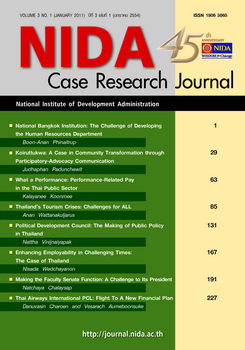What a Performance: Performance-Related Pay in the Thai Public Sector
Keywords:
Performance Management System, Performance–Related Pay, Thai Public SectorAbstract
This case is about a design and implementation of an intervention in performance management system, i.e. performance-related pay scheme. This plan is the first ever in Thai government history which is implemented in 2004 in order to improve the efficiency of the Thai public services. It contains a detailed description of the three basic components of the pay-for-performance scheme – i.e., the performance agreement, the performance evaluation, and the incentive allocation procedures. Information on the allocation of the 5,550 million baht incentives budget whereby all 1.5 million public sector employees – in the departments, higher education institutes, and provinces – could qualify for incentive bonuses based on performance results at both the organization and individual levels, is also included. The case is structured to focus at the dilemma of outcomes of this pay-for-performance scheme. On the one hand, there are many positive assessments from a recent study, including producing many of the intended outcomes and indications of positive support from most officials. On the other hand, magnitude of the dissatisfaction and confusion has become apparent in some segments of the public sector workforce. With this information, the student-analyst must examine the complaints against the design and workings of the performance-related pay scheme, with a view to determining whether the Office of the Public Sector Development Commission, as the major designer and regulator of the performance management system, needs to effect modifications to the system and, if so, what those modifications should be.Downloads
How to Cite
Koonmee, K. (2014). What a Performance: Performance-Related Pay in the Thai Public Sector. NIDA Case Research Journal, 3(1), 63–84. retrieved from https://so04.tci-thaijo.org/index.php/NCRJ/article/view/25070
Issue
Section
Case Study





